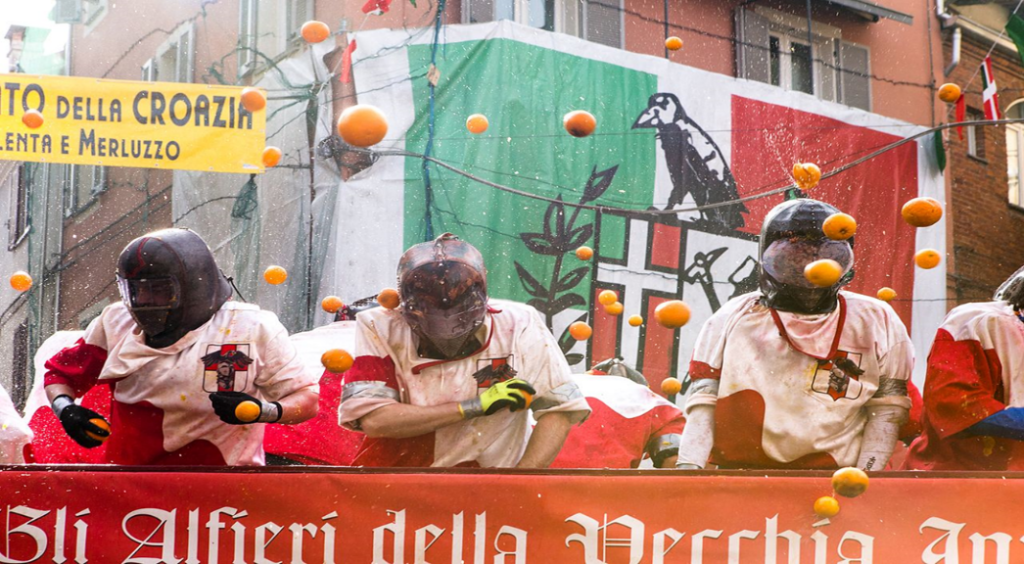Community Building : Community De La Tomatina festival in Spain:
Written by Suvro Sanyal.
La Tomatina is an annual, globally-renowned Spanish festival, where the tomatoes feature heavily during this day-long celebration, as thousands take part in a mass tomato-fuelled food fight. The reason for painting the town red with numerous tonnes of the juicy fruit – is purely, unadulterated enjoyment.
La Tomatina is held in the Valencian town of Bunol, which is situated in the east of Spain, located approximately 30km away from the Mediterranean Sea, which is surrounded by mountain ranges Approximately 9,000 people live in the town, while thousands of tourists visit the region especially to take part in La Tomatina festivities. La Tomatina can trace its roots back to the mid-1940s, when the first public tomato food fight accidentally took place in Bunol.
According to the community to this festival, a parade was taking place in the town square on the last Wednesday of August in 1945, which featured individuals dressed as giants with big heads (gigantes y cabezudos). A group of young people apparently caused the big head of one of the parade’s participants to fall off, a mishap which led the costumed individual to become irate. The unfortunate individual began to cause havoc along the parade route, colliding with a market stall selling tomatoes.
This series of events resulted in spectators picking up the tomatoes and throwing them at one another, sparking the origin of La Tomatina.

The following year, a group of people in the town orchestrated an organised tomato fight, bringing their own tomatoes from home for the occasion. In the early 1950s, La Tomatina was banned from taking place in Bunol by the Spanish dictator Francisco Franco for having no religious significance. However, after a tomato burial was held in 1957 in protest of the decision – during which those in favour of the festival carried a coffin containing a large tomato – La Tomatina was allowed by authorities and made an official festival. In 2002, La Tomatina was declared a Festivity of International Tourist Interest by the Spanish Secretary of the Department of Tourism; since then, it is held annually on the last Wednesday of August.
On the day of La Tomatina, trucks with hordes of tomatoes arrive in Bunol’s Plaza del Pueblo at 11am; Events those usually takes place during the days before the fight commences, include a paella contest near the town’s square, tomato fireworks, and different music bands and parades around the medieval city centre. On Wednesday morning, the first event before the tomato battle is the “Palo Jabón”, centered on a long-greased pole with a piece of ham at its top. The goal is for participants to climb the pole and make the ham drop, which requires them to climb on each other. During this effort, other celebrants sing and dance in circles. Once the ham falls, the tomato battle commences, when water cannons are fired, and lasts for around an hour.
After the cessation of the occassion, trucks are driven around the town which clean the streets by spraying jets of water. Due to the high levels of citric acids in the tomatoes, the streets of Bunol are typically extremely clean once they have been rinsed of tomato residue epitomising hygiene & sanctity.
In the year 2002, the city council had prescribed a short list of instructions for the safety of the participants and the festival, along-with restricting the number of participants to 20,000 only after the petty payment for obtaining entry to the food fight:
- Only tomatoes, and nothing else, should be thrown.
- The participants cannot tear clothes.
- Tomatoes need to be squashed before throwing, avoiding hurting others.
- A safe distance should be maintained from the trucks.
- The participants must stop throwing tomatoes after the second starter pistol is shot.
- Directions given by patrolling security staffs needs to be adhered.
- Tomatoes are to be thrown to the visible targets, to avoid hurting others.
- No tomatoes should be hurled directly at buildings.
- The participants should wear proper clothes, discouraging nudism.
4 : Comunità – Carnival of Ivrea:
The Carnival of Ivrea is a festival is the largest food fight of Italy concurring in the Northern Italian city of Ivrea, a tradition of throwing of oranges between organised groups, known as the “Battle of the Oranges”.

The battle commemorates the city’s defiance against the city’s tyrant, who is either a member of the Ranieri family or a conflation of the 12th-century Ranieri di Biandrate and the 13th-century Marquis William VII of Montferrat. This tyrant attempted to rape a young commoner (often specified as a miller’s daughter) on the evening of her wedding, supposedly exercising the droit du seigneur (was a supposed legal right in medieval Europe, allowing feudal lords to have sexual relations with any female subject, particularly on her wedding night).
The tyrant’s plan backfired, when the young woman instead decapitated her, after which the populace stormed and burned the palace. Each year, a young girl is chosen to play the part of Violetta, the defiant young woman.
During the 19th-century French occupation of Italy, the Carnival of Ivrea was modified to add representatives of the French army. Originally beans were thrown, then apples. Later, in the 19th century, oranges came to represent the stones thrown at the king’s castle to demolish it. The origin of the tradition of throwing oranges is not well understood, particularly as oranges do not grow in the foothills of the Italian Alps and must be imported from Sicily.

The Teams –
The historical foot “aranceri” teams that participate in the defence of Ivrea against the Tyrant’s carted henchmen are 9:
- Aranceri Asso di Picche: red and blue jersey with black neck scarf. Their symbol is a single spade and their home ground is the main town square, which they share with the second oldest throwing team. Created in 1947.
- Aranceri della Morte: black jersey, red pants. Their symbol is a white skull. Created in 1954.
- Aranceri Tuchini del Borghetto: green jersey, red pants and a black crow in a white field on the back. Created in 1964.
- Aranceri degli Scacchi: chequered black and white jersey with an orange tower as their symbol. Created in 1964.
- Aranceri Pantera Nera: black jersey with a black panther on a yellow field on the back. Created in 1965.
- Aranceri Scorpioni d’Arduino: yellow jersey, green pants and a black scorpion as their symbol. Created in 1966.
- Aranceri Diavoli: red and yellow jersey with a red devil. Created in 1973.
- Aranceri Mercenari: maroon jersey, yellow pants. Their symbol is a yellow star with maroon swords. Created in 1974.
- Aranceri Credendari: blue jersey and yellow pants, the Palazzo della Credenza and the town arms as their symbol. Created in 1985.
Another adaptation of the story depicts the fact that the oranges used, symbolises the removal of the testicles of the tyrant.

Writer Suvro Sanyal
Mavericknews30 has launched a series of articles on community building, sharing insights and success stories. Stay tuned for the next article as we explore how to create stronger, more connected communities!
Log on : www.mavericknews30.com
Follows us on : Twitter @mavericknews30
YouTube : @MarvickNews30
“Communities of Circumstance: Support, Conservation, and the Power of Collective Action”
Communities of Circumstance (COC) – Communities of circumstances provide vital …


















